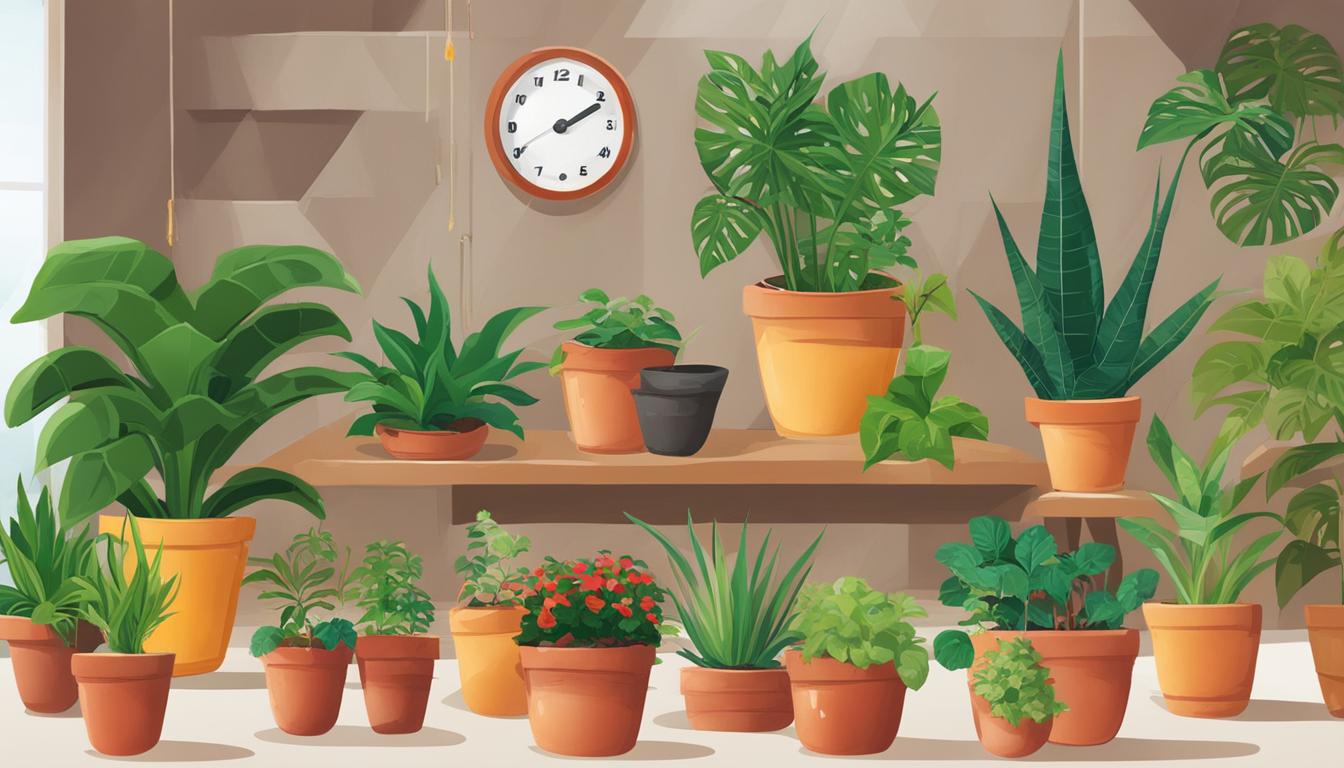
Taking care of indoor plants is essential to ensure they thrive and stay healthy. By following a routine checklist, you can provide your plants with the proper care they need.
Let’s explore the key elements that should be included in an indoor plant care routine checklist.
Key Takeaways:
- Assessing light conditions is crucial for indoor plants’ well-being.
- Proper watering and soil care are essential to prevent under or overwatering.
- Regular fertilization provides indoor plants with necessary nutrients.
- Pruning and maintenance help improve the overall health and appearance of plants.
- Controlling pests and diseases is important to maintain plant health.
Assessing Light Conditions
When it comes to caring for indoor plants, understanding their light requirements is crucial. Different plants have varying needs when it comes to light conditions, and providing them with the right amount of light is essential for their overall health and growth.
To assess the light conditions in your space, start by observing the natural light sources. Are there any windows? If so, which direction do they face? East and west-facing windows generally provide bright, indirect light, while south-facing windows offer the most direct sunlight.
North-facing windows usually receive the least amount of light. Take note of any obstacles that may block sunlight, such as buildings or trees.
Once you have a good understanding of the natural light available in your space, it’s important to match it with the light requirements of your plants.
Some plants thrive in bright, direct light, while others prefer partial shade or low light conditions. Consulting plant care resources or speaking with a local nursery can help you determine the specific light needs of your indoor plants.
Using Light Meters
If you want to get more precise measurements of the light levels in your space, you can use a light meter. These devices can help you gauge the intensity of light and determine if it meets your plant’s requirements. Light meters are especially useful in areas where natural light is limited or inconsistent.
| Light Levels | Requirements |
|---|---|
| Low Light | Less than 100 foot-candles |
| Medium Light | 100-1000 foot-candles |
| Bright Light | 1000+ foot-candles |
Foot-candles is a unit of measurement used to quantify light intensity. By using a light meter, you can determine the foot-candle reading in different areas of your home and ensure that your plants are receiving the appropriate amount of light.
Remember, proper placement is key when it comes to providing the right light conditions for your indoor plants. Consider rotating your plants occasionally to ensure they receive even light distribution and avoid any potential damage from direct sunlight. With proper light assessment and care, your indoor plants will thrive and add beauty to your living space.
Watering and Soil Care
Proper watering is essential for the health of indoor plants. To ensure that your plants receive the right amount of water, it’s important to check the soil regularly. Insert your finger about an inch into the soil to gauge its moisture level. If the soil feels slightly dry, it’s time to water your plant.
When watering your indoor plants, it’s crucial to ensure that the water thoroughly soaks the soil. Avoid shallow watering, as it can lead to inadequate hydration and root problems.
To achieve thorough watering, pour water slowly and evenly around the plant’s base until water starts to drain out of the pot’s drainage holes.
It’s important to use tepid or slightly cool water for indoor plants. Avoid using water that is too hot or too cold, as extreme temperatures can shock the roots. Additionally, be careful not to let your plant sit in a tray or saucer full of water, as this can lead to root rot and other moisture-related issues.
Choosing the Right Potting Soil
The choice of potting soil plays a significant role in the overall health and growth of your indoor plants. Look for a high-quality potting mix that is well-draining and appropriate for the specific needs of your plants. The right potting soil will provide adequate nutrients, support healthy root development, and allow for proper moisture retention and drainage.
When repotting your indoor plants, consider the plant’s growth rate and size. Choose a pot that is slightly larger than the current one, allowing room for the roots to spread and grow. Remember to provide proper drainage by adding a layer of small rocks or broken pottery at the bottom of the pot before adding the potting soil.
| Watering Frequency Guidelines for Indoor Plants | |
|---|---|
| Plant Type | Watering Frequency |
| Succulents and Cacti | Every 2-4 weeks, allowing soil to dry out between waterings |
| Tropical Plants | Once a week, keeping soil slightly moist |
| Leafy Plants (e.g., pothos, philodendron) | Every 7-10 days, allowing the top inch of soil to dry out |
| Flowering Plants | Every 5-7 days, keeping soil evenly moist |
| Herbs | Every 3-5 days, ensuring soil remains consistently moist |
Remember that these watering frequency guidelines are approximate and may vary depending on factors such as humidity levels, temperature, and the size of the pot. It’s important to monitor your plants closely and adjust the watering schedule as needed to prevent under or overwatering.
By following proper watering techniques and choosing the right potting soil, you can ensure that your indoor plants receive the necessary care for healthy growth and vibrant foliage.
Fertilization
Indoor plants rely on regular fertilization to supply them with the necessary nutrients for growth and overall health. Using a suitable houseplant fertilizer can help ensure that your plants receive the right balance of essential elements. When it comes to indoor plant fertilization, there are a few key considerations to keep in mind.
Fertilizer Selection
Choosing the right fertilizer for your indoor plants is crucial. Look for a houseplant fertilizer that is specifically formulated for indoor plants.
These fertilizers typically contain a balanced blend of nitrogen (N), phosphorus (P), and potassium (K), along with other micronutrients. It’s important to follow the package instructions for the correct application rate and frequency.
Additionally, consider the specific needs of your plants. Some plants may require a specialized fertilizer formulation, such as those that prefer acidic or alkaline conditions. Research the specific fertilizer requirements for your indoor plants to ensure you are providing them with the best possible care.
Fertilization Frequency
When it comes to fertilizing indoor plants, it’s important to strike the right balance. Over-fertilization can lead to nutrient burn and damage the plants, while under-fertilization may result in nutrient deficiencies.
As a general rule, it’s best to fertilize indoor plants once per week during the active growing season, typically spring through fall. Reduce or eliminate fertilization during the winter months when most plants enter a period of dormancy.
| Fertilization Frequency | Active Growing Season (Spring-Fall) | Winter Months (Dormancy) |
|---|---|---|
| Frequency | Once per week | Reduce or eliminate |
Fertilization Techniques
Proper technique is essential for effective indoor plant fertilization. Here are some tips to keep in mind:
- Water the plant thoroughly before applying fertilizer to prevent potential root burn.
- Dilute the fertilizer according to the package instructions to avoid over-concentration.
- Apply the fertilizer evenly to the soil surface, taking care to avoid direct contact with the leaves or stems.
- Water the plant again after fertilization to help distribute the nutrients throughout the root zone.
By following these guidelines, you can ensure that your indoor plants receive the necessary nutrients for healthy growth and vibrant foliage.
Pruning and Maintenance
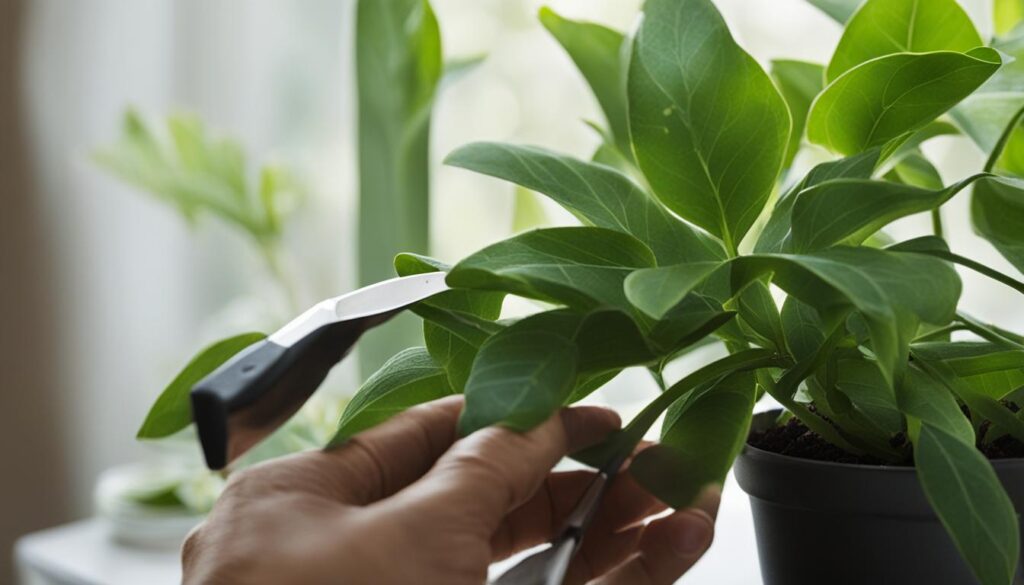
Regular maintenance is essential for the health and vitality of indoor plants. Pruning plays a significant role in maintaining the desired size and shape of your plants. It involves removing dead or withered leaves, promoting better airflow, and improving the overall appearance of your plants.
When pruning indoor plants, use a clean and sharp pair of scissors or pruning shears. Carefully inspect your plants for any dead or yellowing leaves and trim them off at the base.
It’s important to make clean cuts at an angle to prevent additional stress on the plant. By regularly removing dead leaves, you prevent the accumulation of debris and reduce the risk of pests and diseases.
In addition to pruning, general plant maintenance is crucial. Regularly check your plants for signs of pests or diseases, and take appropriate measures to address the issues.
Keep an eye out for any yellowing, wilting, or discoloration of leaves, as these can be signs of underlying problems. Ensure that your plants are receiving adequate sunlight, water, and nutrients according to their specific needs.
Maintenance Checklist:
- Inspect plants for dead or yellowing leaves and prune them off
- Check for signs of pest infestation and treat accordingly
- Ensure plants are receiving appropriate sunlight, water, and nutrients
- Clean and dust plant leaves periodically to improve their ability to absorb light
| Plant | Pruning Technique | Maintenance Tips |
|---|---|---|
| Ficus | Trim to desired shape, remove dead leaves | Keep soil consistently moist, avoid overwatering |
| Spider Plant | Remove brown and withered leaves | Water when soil feels dry, place in bright indirect light |
| Peace Lily | Prune brown or yellow leaves close to the base | Keep soil evenly moist, avoid overwatering or drying out |
Controlling Pests and Diseases
When it comes to indoor plants, pests and diseases can be a common challenge. Taking proactive measures to control and prevent these issues is crucial for the health and well-being of your plants.
By implementing effective pest control strategies and practicing good plant care habits, you can keep your indoor garden thriving. Let’s explore some common houseplant pests, prevention methods, and ways to manage plant diseases.
Pest Identification and Prevention
There are several common pests that can affect indoor plants, including mealybugs, spider mites, scale insects, and fungus gnats. To identify these pests, carefully inspect your plants for signs such as leaf discoloration, webs, sticky residue, or visible insects.
Prevention is key to managing pests, so it’s important to regularly check your plants for early signs of infestation. Avoid over-watering, as this can create a favorable environment for pests. Additionally, isolating new plants before introducing them to your collection can help prevent the spread of pests.
Pest Control Methods
If you discover pest infestations on your indoor plants, there are several effective control methods you can employ. One option is to use an insecticide specifically formulated for houseplants, following the instructions provided on the product label.
Another method is to physically remove pests by gently wiping the leaves with a damp cloth or using a mild soap solution. For severe infestations, you may need to consider pruning or removing heavily affected plant parts.
It’s important to regularly monitor your plants after implementing pest control methods to ensure the issue is successfully resolved.
Preventing Plant Diseases
Plant diseases can also pose a threat to indoor plants, impacting their growth and overall health. To prevent the spread of diseases, it’s important to maintain good hygiene practices.
Avoid over-watering, as excessive moisture can create conditions favorable for fungal and bacterial diseases. Providing proper air circulation by spacing plants appropriately can also help prevent the development and spread of diseases.
If you notice any signs of plant disease, such as wilting, discoloration, or unusual growth patterns, promptly isolate the affected plant to prevent further contamination. Removing and disposing of infected plant parts can also help halt the spread of disease.
| Pest | Description | Prevention |
|---|---|---|
| Mealybugs | Small white insects that leave a cotton-like residue on plants | Regularly inspect plants, isolate new additions, and treat with insecticide |
| Spider Mites | Microscopic pests that cause webbing and leaf stippling | Maintain proper humidity levels and frequently mist plants to deter infestation |
| Scale Insects | Small oval-shaped pests that attach to plant stems and leaves | Inspect plants regularly and remove scale insects manually or with a cloth soaked in rubbing alcohol |
| Fungus Gnats | Small black flies that breed in moist soil and can damage roots | Avoid over-watering and allow soil to dry out between waterings to discourage gnats |
Sunlight Requirements
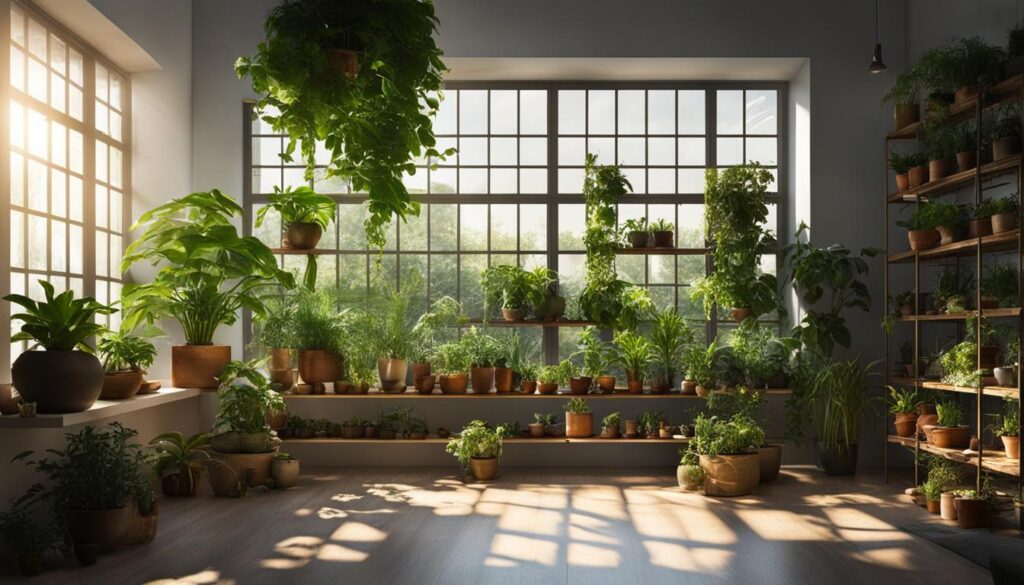
When it comes to indoor plants, understanding their sunlight requirements is crucial for their overall health and growth. Different plants have varying needs when it comes to light exposure, and placing them in the appropriate areas of your home is essential to ensure they receive adequate light.
Some indoor plants thrive in low light conditions, making them perfect for rooms with limited natural sunlight. These plants can tolerate indirect or artificial light and are ideal for areas such as offices or rooms with small windows. Examples of low light plants include snake plants, peace lilies, and zz plants.
On the other hand, there are plants that require medium to high light exposure to thrive. These plants need direct sunlight for a few hours each day and should be placed near windows or in areas where they can receive ample sunlight. Examples of plants that require medium to high light include succulents, cacti, and most flowering plants.
Understanding Your Plant’s Needs
It’s important to research and understand the specific sunlight requirements of the plants you have. This will help you determine the best placement in your home and ensure they receive the appropriate amount of light.
Keep in mind that even plants with similar light requirements may have slight variations, so it’s crucial to read the care instructions specific to each plant.
Observing your plants and paying attention to their growth and appearance can also provide valuable insights. If you notice your plants becoming leggy or stretching towards the light source, it may be an indication that they need more sunlight.
On the other hand, if your plants’ leaves start to wilt or turn yellow, it may be a sign of too much direct sunlight. Adjusting the placement accordingly can help optimize their growth and health.
Remember that while sunlight is crucial for indoor plants, it’s essential to strike a balance. Direct sunlight for extended periods can lead to sunburn and damage the plants.
Similarly, insufficient light can result in weak or stunted growth. By understanding and providing the right amount of light exposure, you can ensure your indoor plants thrive and bring beauty to your living space.
Transplantation: Ensuring Healthy Growth for Indoor Plants
Transplantation is a crucial process in indoor plant care that promotes healthy growth and ensures the well-being of your green companions. As indoor plants grow, they may outgrow their current pot, leading to overcrowded roots and limited access to nutrients.
It’s essential to recognize the signs that indicate a need for transplantation, such as roots growing out of drainage holes or the plant becoming root-bound.
When repotting indoor plants, choose a new container that is one size larger than the current one. This provides the plant with more room for root development and encourages optimal growth. Gently remove the plant from its current pot, being careful not to damage the roots.
Loosen the root ball and place it in the center of the new pot, filling the gaps with fresh potting soil. Ensure the base of the stem is level with the rim of the new pot and firmly press the soil around the roots.
Remember to water the plant thoroughly after transplantation to help settle the soil and ensure proper hydration. Transplantation is also an excellent time to trim any damaged or overgrown roots.
With a sharp, clean pair of scissors or pruning shears, carefully remove any dead or excessively long roots.
By including transplantation as part of your indoor plant care routine, you provide your plants with the space and resources they need to thrive. Remember that different plants have different transplantation needs, so be sure to research the specific requirements for each of your green companions.
Cleaning and Dusting
Regular cleaning and dusting are essential tasks for maintaining the health and appearance of indoor plants. Dust can accumulate on the leaves of plants over time, blocking their ability to absorb light and hindering their growth. By incorporating cleaning and dusting into your indoor plant care routine, you can ensure that your plants thrive and stay vibrant.
To effectively clean your indoor plants, you have a few options. One method is to gently rinse the leaves with water, which helps remove dust and any potential pests.
Another approach is to wipe the leaves with a damp cloth or sponge to eliminate dust. Remember to be gentle and avoid scrubbing or rubbing the leaves too vigorously, as this can damage their delicate structure.
Benefits of Cleaning and Dusting
Cleaning and dusting your indoor plants offer several advantages. Firstly, removing dust helps enhance the plant’s aesthetic appeal, making it look more vibrant and healthy. Secondly, clean leaves enable the plant to efficiently absorb light, promoting photosynthesis and supporting proper growth.
Lastly, regular cleaning helps prevent the buildup of harmful pests, such as spider mites and mealybugs, which can infest plants and cause damage.
It’s important to note that not all plants require the same level of cleaning and dusting. Some plants, such as those with fuzzy or hairy leaves, may be more prone to collecting dust.
These plants may require more frequent attention to keep their foliage clean. However, it’s always a good practice to inspect all your plants regularly and determine their individual cleaning needs.
Seasonal Care
Proper care for indoor plants may vary depending on the season. Each season brings different environmental factors that can affect plant growth and health.
By adjusting your care routine accordingly, you can ensure that your plants thrive throughout the year. Here are some seasonal care tips to help you maintain healthy and beautiful indoor plants.
Spring:
In spring, as plants enter their active growth phase, it is a good time to provide some extra care. This includes repotting any plants that have outgrown their current containers. Transplanting them into larger pots will give the roots more room to grow and support healthy development.
Spring is also a great time to fertilize your indoor plants. Use a well-balanced houseplant fertilizer and follow the package instructions for application. This will provide your plants with the nutrients they need to thrive.
Summer:
During the summer months, indoor plants may require more frequent watering due to increased temperatures and higher evaporation rates. Monitor the moisture levels in the soil regularly and adjust your watering schedule accordingly.
It’s important not to overwater or let your plants sit in standing water, as this can lead to root rot. Additionally, consider moving your plants to areas with indirect or filtered sunlight to protect them from intense heat and direct sunlight.
Fall and Winter:
In the fall and winter, indoor plants generally experience slower growth and may require less frequent watering. Monitor the soil moisture levels and adjust your watering schedule accordingly, allowing the soil to slightly dry out between waterings.
During this time, it’s also important to keep your plants away from cold drafts or areas with fluctuating temperatures. Consider placing them in a warm and well-lit spot, away from windows that may get chilly at night.
By adapting your care routine to the changing seasons, you can ensure that your indoor plants receive the optimal care they need for healthy growth and longevity.
| Season | Tips |
|---|---|
| Spring | Repot plants that have outgrown their containers. Fertilize with a balanced houseplant fertilizer. |
| Summer | Water more frequently and provide shade from intense sunlight and heat. |
| Fall and Winter | Water less frequently and protect plants from cold drafts and fluctuating temperatures. |
Troubleshooting Common Issues
Indoor plants can encounter various issues that may affect their health and appearance. It’s crucial to address these problems promptly to ensure the well-being of your plants. Let’s explore some common indoor plant issues and their solutions:
Sunburn
One common issue with indoor plants is sunburn, which occurs when they are exposed to excessive sunlight. Signs of sunburn include yellowing or brown patches on the leaves.
To prevent sunburn, ensure that your plants are placed in areas with the appropriate amount of light for their specific requirements. If you notice signs of sunburn, move the plant to a shadier spot and gradually reintroduce it to sunlight.
Under-watering
Under-watering is another problem that can affect indoor plants. Signs of under-watering include drooping leaves, dry soil, and wilting. To remedy this, thoroughly water your plants when the top inch of soil feels dry.
Ensure that water drains properly, and avoid letting the plant sit in standing water. It’s important to establish a watering schedule based on your plant’s needs, as each species may have different water requirements.
Over-watering
Over-watering is a common mistake that can lead to root rot and other detrimental effects on indoor plants. Signs of over-watering include yellowing leaves, mushy roots, and a foul smell coming from the soil. To prevent over-watering, allow the soil to dry out before watering again.
Make sure the pot has proper drainage and avoid excessive watering, especially during the dormant period for your plants.
Exposure to Cold Temperatures
Indoor plants are sensitive to cold temperatures, so it’s important to protect them from drafts and extreme cold. Exposure to low temperatures can cause leaf discoloration, wilting, or even plant death.
To avoid this, keep your plants away from drafty windows and doors during the colder months. If necessary, provide additional insulation or move them to a warmer location in your home.
By being proactive in identifying and addressing common indoor plant issues, you can ensure the health and vitality of your plants. Remember to regularly observe and care for your indoor plants to prevent problems before they arise, and always research the specific needs of each plant species in your care.
FAQ
What should be included in an indoor plant care routine checklist?
To ensure the health and well-being of your indoor plants, your care routine checklist should include assessing light conditions, proper watering and soil care, fertilization, pruning and maintenance, controlling pests and diseases, understanding sunlight requirements, transplantation, cleaning and dusting, seasonal care, and troubleshooting common issues.
How can I assess light conditions for my indoor plants?
Before bringing home a new plant, it’s important to assess the light conditions in your space. Different plants have varying light requirements, such as bright, partial, or low light. Checking the light levels and understanding the specific needs of your plants will help you determine the appropriate placement and ensure their well-being.
How often should I water my indoor plants?
Proper watering is crucial for indoor plants. Check the soil regularly by feeling the surface to determine when it’s slightly dry. When watering, ensure the water thoroughly soaks the soil and drains out of the pot’s drainage holes. Additionally, use tepid or slightly cool water and avoid letting the plant sit in a tray full of water. It’s also important to choose the right potting soil and ensure it has good drainage to prevent overwatering.
How often should I fertilize my indoor plants?
Indoor plants benefit from regular fertilization to provide them with necessary nutrients. Use a fertilizer specifically formulated for houseplants and follow the package directions for application. It’s best to fertilize once per week during the spring through fall seasons. Avoid over-fertilization, as it can harm the plants.
How should I prune and maintain my indoor plants?
Regular maintenance is essential for indoor plants. Remove dead or withered leaves by clipping them with a scissor. This helps improve the plant’s appearance and overall health. Additionally, if a plant becomes too large or has an awkward shape, gentle pruning can be done to maintain its desired size and shape.
How can I control pests and diseases in my indoor plants?
Keep a close eye on your indoor plants for pests such as mealybugs, spider mites, scale, and fungus gnats. If detected, use an insecticide formulated for houseplants to treat the infestation. Preventing diseases in indoor plants can be done by avoiding over-watering, ensuring proper air circulation, and maintaining good hygiene practices.
What are the sunlight requirements for indoor plants?
Different indoor plants have varying sunlight requirements. Some thrive in low light conditions, while others require medium or high light exposure. Understanding the sunlight needs of your plants will help you place them in the appropriate areas of your home to ensure they receive adequate light for their growth and development.
When should I consider transplanting my indoor plants?
As indoor plants grow, they may outgrow their current pot. If you notice roots growing out of the drainage holes or the plant becoming root-bound, it’s time to consider transplanting it into a larger container. Transplantation provides the plant with more room for root growth and ensures its continued health.
How should I clean and dust my indoor plants?
Regular cleaning and dusting are important to maintain the health and appearance of indoor plants. Rinse the plant’s leaves occasionally to remove dust or wipe them with a wet cloth. This helps improve the plant’s ability to absorb light and ensures healthy growth.
How should I adjust my care routine for indoor plants during different seasons?
Indoor plants may require different care during different seasons. Adjust your care routine accordingly, considering factors such as temperature, humidity, and light levels. During the spring, it’s a good time to repot, fertilize, and provide additional care as plants enter their active growth phase.
What are some common issues I may face with indoor plants and how can I address them?
Indoor plants can face various issues, such as sunburn, under-watering, over-watering, and exposure to cold temperatures. It’s important to identify and address these issues promptly to ensure the plant’s well-being. Understanding common plant care problems and their solutions will help you maintain healthy and thriving indoor plants.

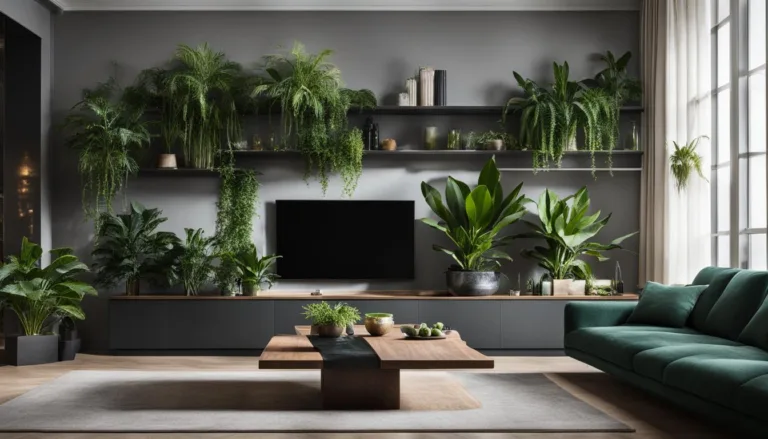
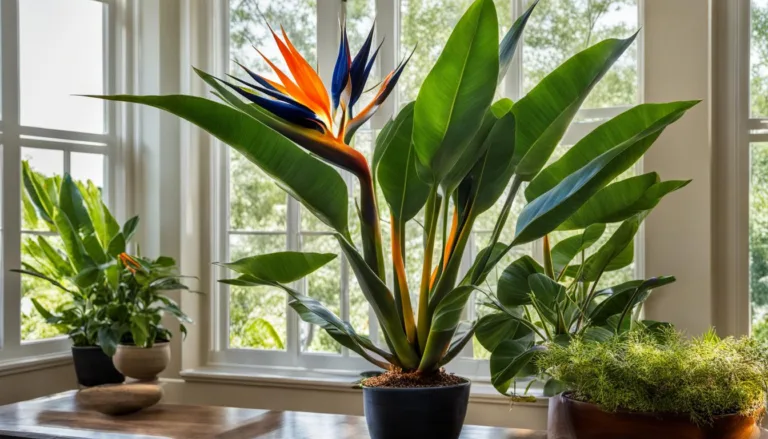
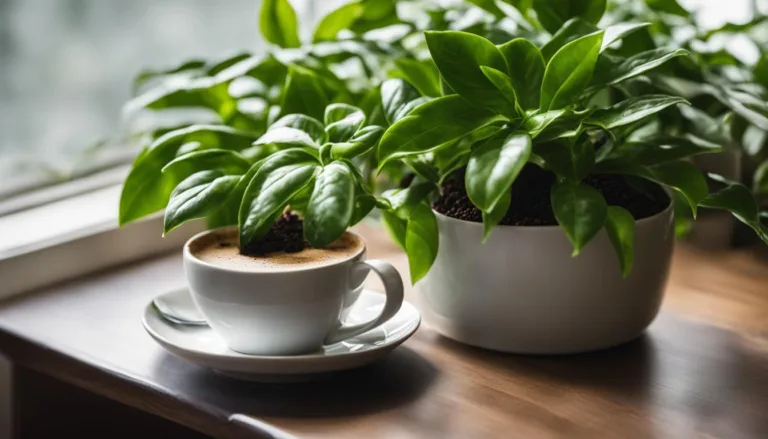
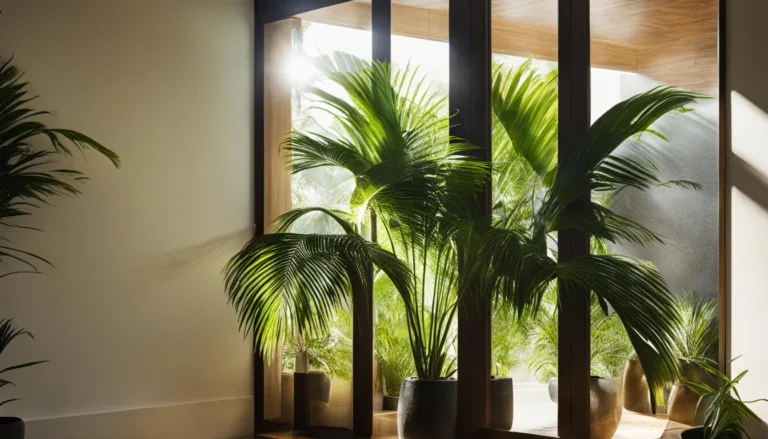
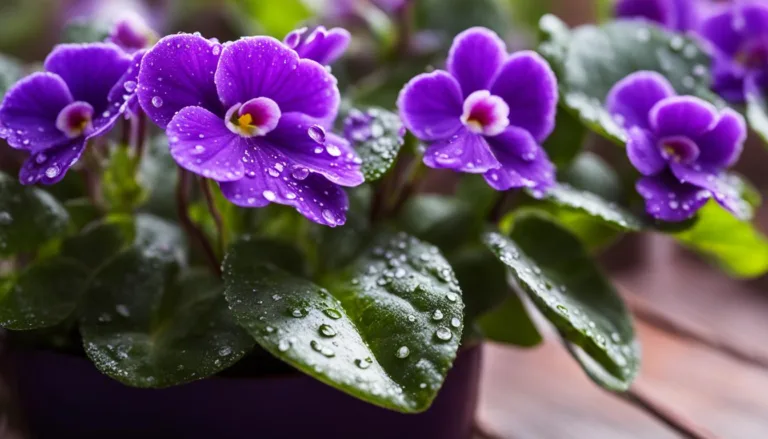

4 Comments